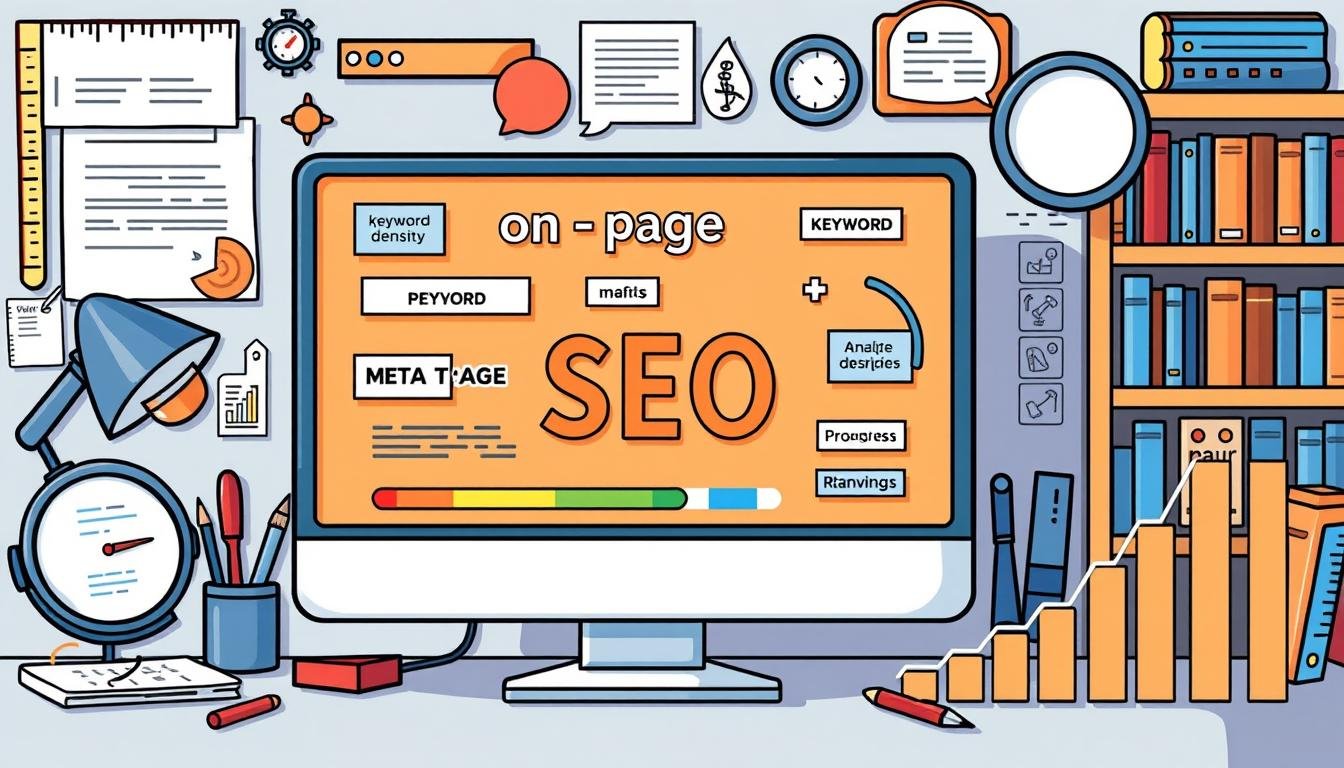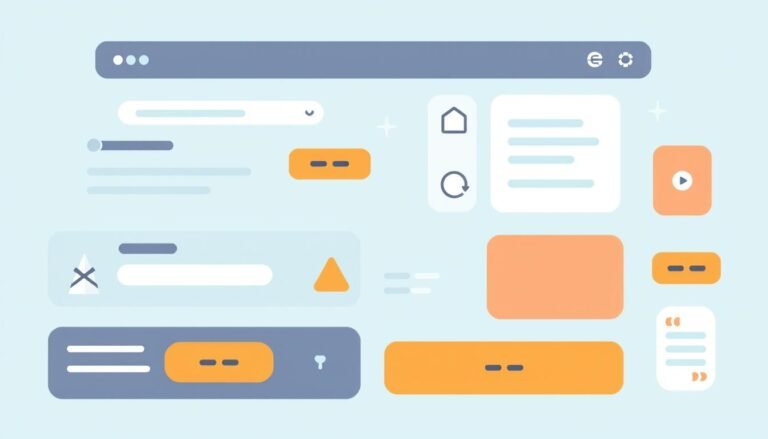Complete Guide to On-Page SEO Optimization
Did you know that 70% of online marketers think on-page SEO is key for getting more organic traffic? In today’s digital world, it’s tough to stand out. But, by optimizing your website for search engines, you can boost your visibility and get more people to engage with your content. This guide will show you the basics of on-page SEO and how to make your website better by changing your content and structure.
On-page SEO covers everything from the content you share to the HTML tags you use. As the website owner, you have full control over these important parts. You need to pick the right topics, keywords, and audience to make your strategy work. Good on-page SEO does more than just make you visible. It ensures your content is easy to find, high quality, and seen as an expert in your field. Studies show that a strong on-page SEO plan can bring more website visitors and keep them interested, proving its value in today’s competitive market.
Key Takeaways
- On-page SEO focuses on optimizing front-end and back-end components of a website.
- Page titles and meta descriptions are key to getting more clicks from search results.
- Keyword research is crucial for knowing what to optimize for.
- Visual content makes the user experience better and keeps people engaged.
- Internal linking helps with site navigation and boosts SEO performance.
- On-page SEO should be a constant effort to stay ahead in the competition.
What is On-Page SEO?
On-page SEO, also called on-site SEO, is key to making a website perform better. It makes sure different parts of a webpage are optimized to show up more in search results. Important parts include content quality, HTML tags, and how the page is structured. By using on-page SEO well, it makes search engines crawl and index the site easier, which can lead to better rankings.
Understanding the Basics of On-Page SEO
SEO basics cover many techniques to make websites better for users and search engines. These include:
- Keyword Optimization: Choosing the right keywords and putting them in content, titles, and headings.
- Content Quality: Making content that is valuable and answers user questions.
- Meta Tags: Writing catchy title tags and meta descriptions to get more clicks.
- Image Optimization: Using clear filenames and alt text for images to help Google understand them.
For example, changing one word in a blog post title can move it up seven spots in search results. This shows how small changes can greatly affect rankings.
Difference Between On-Page and Off-Page SEO
It’s important to know the difference between on-page and off-page SEO for a complete SEO plan. On-page SEO deals with what’s inside the website, like content and HTML tags. Off-page SEO looks at outside factors, like backlinks and social shares, that affect a site’s authority.
| Element | On-Page SEO | Off-Page SEO |
|---|---|---|
| Focus | Internal website elements | External factors |
| Examples | Content, keywords, HTML tags | Backlinks, social media signals |
| Impact | Directly affects rankings | Affects authority and reputation |
Knowing these differences helps create a well-rounded approach to on-page and off-page SEO. This leads to better page optimization strategies.
Why On-Page SEO is Important
On-page SEO is key to getting noticed online. It helps webmasters share important info with search engines. This boosts the site’s visibility in search results.
Good on-page SEO makes it easier for search engines to understand your site. This leads to better rankings and more visitors.
Enhancing Visibility in Search Engine Results
On-page SEO makes it easier for people to find what they’re looking for. By using title tags, meta descriptions, and keywords smartly, sites can climb up in search results. Keywords in headlines and body text also help.
Using tools like WordPress and Drupal makes SEO easier. These platforms help site owners keep their content optimized.
Providing Value to Users
Creating content that stands out is crucial. Google likes content that answers user questions well. Writing specific metadata for each page helps match content with user needs.
Good internal linking makes a site look trustworthy and keeps users interested. Looking at what others do helps understand what users want. This way, you can make content that really matters.
Complete Guide to On-Page SEO Optimization
Effective on-page SEO is key to making your site more visible and performing better. It helps you optimize your site well, making it better for users and search engines. This guide will cover the main parts and factors of on-page SEO that are important for success.
Key Components and Elements of On-Page SEO
The components of on-page SEO include many important parts for making webpages better. These parts are:
- Content quality: Making content that grabs users’ attention.
- Keyword density: Using keywords the right amount in content.
- Title and description: Writing catchy title tags and meta descriptions.
- URL structure: Making URLs that help with SEO.
- Page experience: Improving user experience with mobile friendliness and speed.
- Media optimization: Using images and videos to make content better.
- Internal and external links: Linking to content inside and outside your site smartly.
Understanding the SEO Factors
Knowing the SEO factors that affect rankings on Google is crucial. Google looks at things like HTTPS for security and page speed as important factors. Using tools like SE Ranking’s On-Page SEO Checker checks over 94 parameters, giving a score from 0 to 100. This helps users see where they can get better.
Choosing Target Keywords and Topics
Choosing the right keywords and topics is vital for on-page SEO. Use tools like Ahrefs and Google Analytics to find keywords that match what users are searching for. Looking at what competitors do can show you new keywords and ways to improve. Using data and learning from others can make your pages better and help your rankings.
On-Page SEO Tactics for Content Optimization
To make content better, using on-page SEO tactics is key. Doing focused keyword research helps businesses find the right keywords. This makes sure their content matches what people are searching for. Creating unique content is also crucial, helping websites stand out online.
Here are some ways to make your content better with on-page optimization.
Conducting Effective Keyword Research
Good keyword research is the first step in optimizing content. Focus on one keyword per page to target search queries well. Choosing keywords that match what users are looking for improves your site’s visibility and ranking.
Putting these keywords in title tags, meta descriptions, and headings makes your content clear to users and search engines.
Creating Unique and Valuable Content
In today’s fast-paced world, creating unique content is a must. Aim for blog posts that are at least 1,500 words long. They should be full of useful information without unnecessary fluff.
Content that engages and informs readers keeps them on your page longer. This is good for metrics like dwell time. Using keywords in your text helps people find what they need quickly.
Optimizing Content for Search Intent
Understanding what users want is key to optimizing for search intent. By knowing the user’s journey from awareness to decision, marketers can make better content. Using heading tags and subheadings helps guide readers through your content.
Images are also important. Optimizing them for speed and using alt text with targeted keywords boosts your SEO.
| On-Page SEO Techniques | Description |
|---|---|
| Keyword Research | Identify relevant keywords to align with user search behaviors. |
| Content Length | Aim for a minimum of 1,500 words, ensuring comprehensive coverage. |
| Keyword Placement | Include keywords in titles, headings, and meta descriptions. |
| Image Optimization | Optimize images for speed, using alt text with relevant keywords. |
| Unique Content | Create original content that provides real value to users. |
| Headings Usage | Use various heading tags to organize content for better readability. |
Meta Tags Optimization for Improved Click-Through Rates
Meta tags are key for better on-page SEO and higher click-through rates (CTR). Using title tag strategies and writing meta descriptions helps grab users’ attention. It also boosts search engine visibility.
Crafting Compelling Title Tags
Title tags are the first thing people see in search results. They should be short, between 50-65 characters, to be fully visible. Including main keywords early makes the title more relevant to what users are searching for.
Having unique title tags for each page helps search engines understand your content better. This makes it easier for users to find what they’re looking for.
Writing Generate Meta Descriptions
Good meta description writing can really boost user engagement. Aim for about 155-160 characters to give a quick summary of your page. Adding calls-to-action like “Learn more” or “Shop now” might encourage users to click.
Each page should have its own meta description. Use primary keywords to make them stand out and relevant.
Importance of Image Alt-Text
Optimizing images with alt attributes helps with accessibility and SEO. Alt text describes images, helping visually impaired visitors and giving context to search engines. Well-written alt-text also boosts keyword relevance, supporting your SEO strategy.
By describing images well, you make them a key part of your SEO plan. This attracts more organic traffic to your site.
Improving URL Structure and Internal Linking Strategy
Creating a clear URL structure is key for SEO and user experience. SEO-friendly URLs help users know what to expect before they click. This makes browsing smoother, which can lead to more engagement and lower bounce rates.
Creating SEO-Friendly URL Structures
Here are tips for a good URL structure:
- Keep URLs short and filled with keywords.
- Use hyphens to separate words.
- Follow a logical structure that mirrors your site’s layout.
- Remove unnecessary parameters and words.
SEO-friendly URLs are not just for rankings. They also make it easier for users to navigate your site.
Benefits of an Internal Linking Strategy
A solid internal linking strategy helps search engines crawl your site better. Here are the main benefits:
- Improves indexing efficiency.
- Transfers authority from top pages to relevant sub-pages.
- Encourages users to explore more, leading to longer visits.
- Signals important pages to search engines with a clear hierarchy.
There are different ways to link within your site, like through menus, in the text, or in footers. Make sure anchor texts are short and relevant. Regularly checking your links helps keep your SEO in check and prevents lost pages. Linking from strong pages like the homepage can boost your site’s ranking.
| Strategy | Purpose | Best Practices |
|---|---|---|
| Concise URL Structuring | Aid user navigation | Keep URLs short and descriptive |
| Internal Linking | Enhance crawlability | Link high-performing pages to others |
| Using Descriptive Anchor Text | Improve contextual relevance | Make sure it reflects linked content |
| Regular Link Audits | Optimize SEO performance | Check link effectiveness and page authority |
Conclusion
On-page SEO is key for winning in the digital world. It’s not just a one-time task. It needs ongoing work on things like content quality, meta tags, and linking strategies. This helps businesses show up more in search results and get more visitors.
This guide shows how good on-page SEO helps with more clicks and keeping users interested. For example, being at the top of search results can boost clicks by up to 32%. Also, 64% of marketers are working hard to improve their search rankings.
Improving on-page strategies is vital for staying relevant in search results. Using tools like SE Ranking helps website owners track their progress and adjust as needed. So, focusing on on-page SEO brings quick wins and sets up success for the future in digital marketing.
Source Links
- The Ultimate Guide to On-Page SEO in 2024
- The Complete Guide to On-Page SEO
- On-Page SEO: How to Optimize for Robots and Readers
- On-Page SEO [Beginner’s Guide to SEO]
- What is On-Page SEO Optimization and How to Implement | Mailchimp
- On-Page SEO: The Definitive Guide + FREE Template (2024)
- On-Page SEO: The Practical Guide For SEO Beginners [2024]
- The complete guide to on-page optimization
- On-Page SEO: The Complete Guide for 2024 – WordStream
- On-Page SEO: What It Is and How to Do It
- Meta Tags: What They Are & How to Use Them for SEO
- Ultimate Guide to SEO-Friendly Meta Tags for 2024
- Meta Tags For SEO: A Simple Guide For Beginners
- Internal Linking for SEO: The Complete Guide
- Internal Links: Ultimate Guide + Strategies
- Complete Guide to Internal Links SEO: Strategies and Best Practices | Clearscope
- Complete Guide to On-Page SEO Optimization in 2024 | ResultFirst








